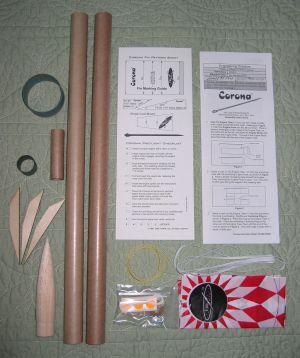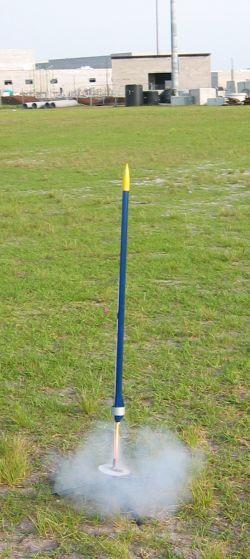| Construction Rating: | starstarstarstarstar |
| Flight Rating: | starstarstarstarstar_border |
| Overall Rating: | starstarstarstarstar |
| Diameter: | 0.98 inches |
| Length: | 41.00 inches |
| Manufacturer: | FlisKits  |
| Style: | Ring/Tube/Cone Fin |
 Brief:
Brief:
This is an updated version of the FlisKits Corona. To prepare the Corona for the release of the optional Corona-2 booster, FlisKits now includes laser cut plywood fins instead of balsa fin stock and a pattern so the builder no longer has to cut out the fins.
Construction:
There are 3 minor changes to the build of the Corona:
The builder has the choice of building the motor mount with or without the metal retainer hook.
- If you plan on building and using the Corona-2, then you have to build it without the motor hook!
- The aforementioned laser cut 1/16" thick birch plywood fins. Aside from being single piece fins, they also include a tiny lip on the aft end of the tip cord to properly align the ring fin.
- The ring fin should not be painted if you plan on building and using the Corona-2 because the paint's thickness could cause the booster to not deploy at sustainer ignition.

The instructions included plenty of diagrams and easy-to-understand text to guide the builder through construction. The instructions also did a fantastic job of pointing out any potential gotchas that might occur during the build. With the new parts, the build has been simplified--particularly if you are going to build the Corona-2 afterwards, which is what I did.
The only step that I deviated from was where I was supposed to sand a bevel onto the leading and trailing edges of the fins. With the fins being so thin, I decided to sand the edges smooth but did not shape them.
Other than that, I built the kit completely stock. I did not find any potential flaws in the design or components of the kit. The parts are all top notch and there is the attention to detail like having the Kevlar/elastic shock cord attached to the coupler joining the 2 BT-50 body tubes, which puts it even at its closest quite a ways from the proximity of the motor ejection (although wadding it still definitely required).
Finishing:
Keep in mind, I didn't glue the ring fin on till after I did all of my painting since I was planning to use this in a 2-stage configuration with the Corona-2!
I began the finishing process by applying diluted Elmer's Fill 'n' Finish to the fins and balsa nose cone and then sanding them down until smooth with 320 grit sandpaper. The entire rocket was given a couple coats of Krylon white primer and were sanded with 400 grit sandpaper after each coat. The nose cone was painted Krylon Sun Yellow Gloss separately while the rest of the rocket was painted Krylon Regal Blue Gloss.
For the ring fin I pulled out a technique used by folks who build competition models: I used a silver metallic Sharpie Marker to color the outside of the ring fin! It did a great job covering the funky blue-green paper of the ring fin and matched up with the silver automotive pinstriping I put on the nose cone for accent.
The last step was to attach the ring fin. I started by roughing up the tip cord on each of the fins with a little sandpaper. Then I smeared some glue at 120 degree intervals on the inside of the ring fin. I carefully slid it along most of the length of the rocket and into place resting on each of the 3 fins.
Construction Rating: 5 out of 5

Flight:
I flew the Corona twice. First it went solo on a C6-7. The quick boost was nice and straight to about 700 feet. No anomalies in flight were observed. It arced over and ejected a second or so past apogee. The shorter delay of a C6-5 is probably a better match for single stage flights for a C motor. A B6-4 should be an excellent match for this rocket on windy days or if the launch field isn't big enough to support such high altitude flights.
The second flight was on another C6-7 as the sustainer for the Corona-2 booster. The booster carried the rocket upwards in the neighborhood of 400 feet before the sustainer motor ignited perfectly. I did not see any deviation in the sustainer's trajectory after separation as it continued up to a good 1200 feet and ejected right at apogee.
Recovery:
The Kevlar/elastic shock cord should please the experienced LPR builders out there. There is plenty of both included with the kit so there is all but zero chance of the nose cone snapping back.
The parachute in the kit is the user customizable plastic chute that comes with most kits from FlisKits. You have your choice of a 14", 12", or 10" chute. I was concerned about the drift of the Corona, particularly when used with the Corona-2 booster so I opted to cut it out along the 12" lines as well as remove the 2" diameter FlisKits logo in the center for a spill hole. (I have to admit that I hate cutting out the manufacturer's product logo from the plastic chute but that's where they choose to put it!) I do prefer to have my rockets recover on the fast side, but I almost always launch at sites where there is plenty of grass to absorb the impact too.
On the first flight, I think I may have packed the Estes wadding a little too far down the body tube as the nose cone separated at ejection but the shock cord and chute didn't fully come out of the rocket. It drag recovered landing on a pile of dirt. This put a slight kink in the body tube just forward of the fins. There was more damage to my pride than the cosmetics of the rocket.
The second flight was the same day and right after the first one. The chute opened without any issues this time and the light winds carried the Corona just out of the field. Thankfully it cleared the power lines but into an are with quite a few trees. The rocket gods smiled on me though and allowed it to land in a small clearing. There was no damage upon recovering it.
Flight Rating: 4 out of 5
Summary:
The Corona is a sleek kit capable of some impressive altitude on low power motors but is easily tracked during flight thanks to its long profile. Flown as a single stage it will almost certainly always give a good flight but when used as a sustainer with the Corona-2, it'll get a lot of attention!
Overall Rating: 5 out of 5
Other Reviews
- FlisKits Corona By Nick Esselman
" Futuristic Starship Design " " Long, sleek appearance " " Highly stable for fantastic flights! " " Wind cheating design for extreme altitudes! " Those are the headlines on the FlisKits Corona. The Corona is a "longneck" rocket with and interesting, perhaps one would say, futuristic, ...
- FlisKits Corona By Greg Deeter
This is a single stage rocket, skill level 2 from the new company FlisKits. It has an interesting fin area with a ring. It says that it was first introduced at the Seventh Annual North East Model Rocket Convention (NEMROC7). I ordered this direct from FlisKits online and had it in 2-3 days by mail. The package is very nice looking. It came in a retail type bag (like Estes) with a hole punched ...
 |
 |
Flights
 |
 |
Sponsored Ads
 |
 |












J.F. (January 3, 2003)